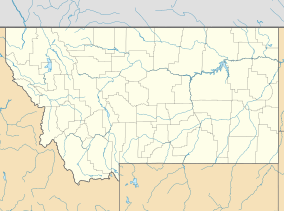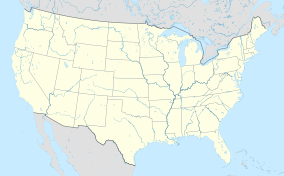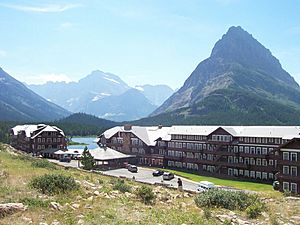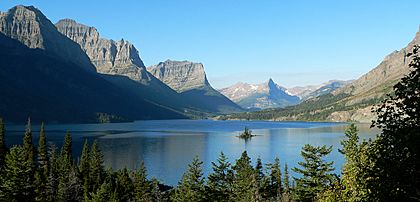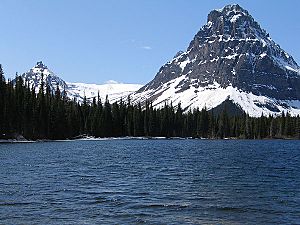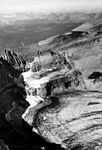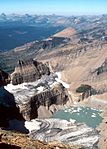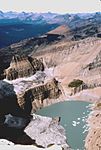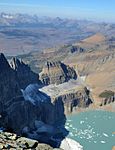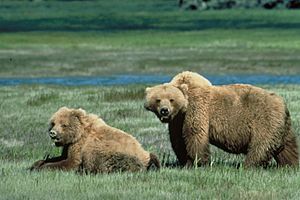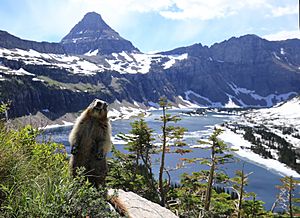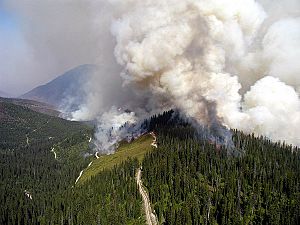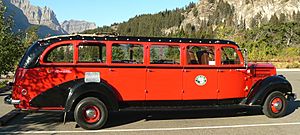Glacier National Park (U.S.) facts for kids
Quick facts for kids Glacier National Park |
|
|---|---|
|
IUCN Category II (National Park)
|
|
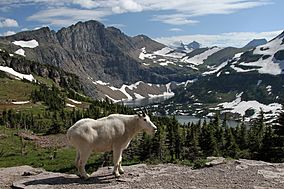
Mountain goat, official park symbol, above Hidden Lake
|
|
| Location | Flathead County & Glacier County, Montana, United States |
| Nearest city | Columbia Falls, Montana |
| Area | 1,013,322 acres (4,100.77 km2) |
| Established | May 11, 1910 |
| Visitors | 3,049,839 (in 2019) |
| Governing body | National Park Service |
| Website | Glacier National Park |
| UNESCO World Heritage Site | |
| Part of | Waterton-Glacier International Peace Park |
| Criteria | Natural: vii, ix |
| Inscription | 1995 (19th Session) |
Glacier National Park is a beautiful national park in northwestern Montana, USA. It sits right on the border with Canada, next to the provinces of Alberta and British Columbia. This huge park covers over 1 million acres (4,000 km²).
Inside the park, you'll find parts of two big Rocky Mountains ranges. There are also more than 130 named lakes and over 1,000 different kinds of plants. Hundreds of animal species call this park home. This amazing natural area is often called the "Crown of the Continent Ecosystem." It's a protected region covering about 16,000 square miles (41,000 km²).
Long ago, Native Americans lived in the area that became Glacier National Park. The Blackfeet lived in the east, and the Flathead lived in the west. In 1895, the Blackfeet sold some of their mountain lands to the U.S. government. This land later became part of the park.
Glacier National Park was officially created on May 11, 1910. Soon after, the Great Northern Railway built many hotels and chalets. These buildings helped people visit the park. Today, these historic places are very important and are listed as National Historic Landmarks. About 350 spots in the park are on the National Register of Historic Places.
By 1932, the famous Going-to-the-Sun Road was finished. This road made it much easier for cars to reach the heart of the park. It's now a National Historic Civil Engineering Landmark.
The mountains in Glacier National Park started forming about 170 million years ago. Old rocks were pushed up and over younger rocks. This event is called the Lewis Overthrust. The rocks here have some of the best fossils of early life on Earth.
The shapes of the Lewis and Livingston mountain ranges show signs of huge glaciers. These glaciers carved out U-shaped valleys and created lakes. In the mid-1800s, there were about 150 glaciers in the park. By 2010, only 25 active glaciers remained. Scientists think all active glaciers might disappear by 2030 if the climate keeps warming.
Glacier National Park still has almost all its original plants and animals. Large mammals like grizzly bears, moose, and mountain goats live here. Rare animals like wolverines and Canadian lynxes also call the park home. There are hundreds of bird species, many fish, and some reptiles and amphibians. The park has many different environments, from prairie to high tundra.
Forest fires are common in the park. Almost every year since the park was created, there has been a fire. In 2003, six fires burned over 136,000 acres (550 km²). This was more than 13% of the park's total area.
Glacier National Park is connected to Waterton Lakes National Park in Canada. Together, they are called the Waterton-Glacier International Peace Park. In 1932, they became the world's first International Peace Park. Both parks are also Biosphere Reserves and World Heritage Sites.
Contents
Exploring the Park's Past
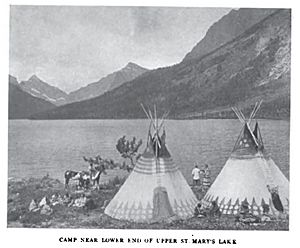
People have lived in the Glacier area for about 10,000 years. The first groups connected to today's tribes were the Flathead (Salish) and Kootenai, Shoshone, and Cheyenne. The Blackfeet lived on the eastern side of the mountains. The park's mountains gave them shelter from winter winds. They could also hunt other animals besides bison.
Today, the Blackfeet Indian Reservation is east of the park. The Flathead Indian Reservation is to the west and south. In 1895, the Blackfeet sold about 800,000 acres (3,200 km²) of mountain land to the U.S. government. They were allowed to keep hunting rights on this land.
In 1806, the Lewis and Clark Expedition came close to the park area. Later, explorers helped us understand the region better. In 1885, George Bird Grinnell went on a hunting trip there. He loved the scenery so much that he spent 20 years trying to make it a national park. In 1901, Grinnell called the region the "Crown of the Continent."
The Great Northern Railway reached the park's southern border in 1891. The railway wanted more people to use their trains. So, they told everyone how beautiful the area was. In 1897, the park became a forest preserve. This meant mining was still allowed, but it wasn't very successful.
People kept working to protect the area. In 1910, a bill was passed in the U.S. Congress. President William Howard Taft signed it into law. This officially made the region a national park.
Historic Buildings and Roads
From 1910 to 1913, the Great Northern Railway built many hotels and chalets. These buildings were designed to look like Swiss architecture. This was part of a plan to make Glacier seem like "America's Switzerland." The hotels helped bring thousands of visitors to the park by train. People often rode horses or stagecoaches between the lodges.
Some of the chalets were in remote areas, only reachable by trail. Today, only Sperry, Granite Park, and Belton Chalets are still open. The surviving hotels and chalets are now National Historic Landmarks. In total, 350 buildings in the park are listed on the National Register of Historic Places. These include ranger stations and fire lookouts.
After more people started driving cars, work began on the Going-to-the-Sun Road. This 53-mile (85 km) road was finished in 1932. It cuts through the park and crosses the Continental Divide at Logan Pass. The Sun Road is also on the National Register of Historic Places.
The Civilian Conservation Corps (CCC) helped develop the park from 1933 to 1942. This group of young men worked on reforestation, building campgrounds, and creating trails. They also helped reduce fire risks and fight fires.
How the Park is Managed
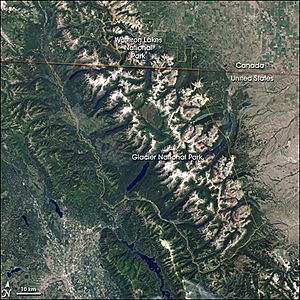
Glacier National Park is managed by the National Park Service. The park's main office is in West Glacier, Montana. In 2019, about 3.5 million people visited Glacier National Park.
The park has a budget to keep it running. Major work was done on the Going-to-the-Sun Road for the park's 100th anniversary in 2010. They also improved visitor centers, hotels, and campgrounds.
Hunting, mining, logging, and removing natural resources are not allowed in the park. Oil and gas exploration are also forbidden. These rules sometimes caused problems with the nearby Blackfeet Indian Reservation.
Most of Glacier National Park is managed as a wilderness area. This means it is kept as natural as possible. About 93% of the park is managed this way, even though it hasn't been officially called a wilderness area by Congress.
Mountains, Lakes, and Waterfalls
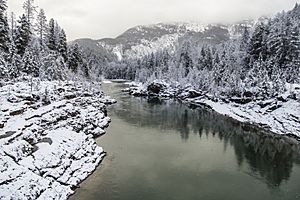
The park is surrounded by other protected lands. To the north are Waterton Lakes National Park in Canada and other provincial parks. The Flathead River forms parts of the park's western and southern borders. The Blackfeet Indian Reservation is on the eastern side.
Glacier National Park has many lakes. There are a dozen large ones and 700 smaller ones. Only 131 lakes have names. Lake McDonald is the longest and deepest lake in the park. It's 9.4 miles (15 km) long and 464 feet (141 m) deep.
Many small lakes, called tarns, are found in bowl-shaped areas carved by glaciers. Some lakes, like Avalanche Lake, are a bright turquoise color. This color comes from tiny rock dust left by glaciers. The lakes in Glacier National Park are always cold. This means they have very clear water.
The park also has about 200 waterfalls. During dry times, many of them become small trickles. Some of the largest falls are in the Two Medicine region and the Many Glacier area. Bird Woman Falls is one of the tallest, dropping 492 feet (150 m).
Park Geology: Ancient Rocks and Fossils=
The rocks in the park are mostly sedimentary rocks. They formed in shallow seas over 800 million to 1.6 billion years ago. During the formation of the Rocky Mountains, a huge section of rocks, called the Lewis Overthrust, slid eastward. This means older rocks ended up on top of much younger ones.
Chief Mountain is a great example of this. It's a tall peak that rises 2,500 feet (760 m) above the Great Plains. There are six mountains in the park over 10,000 feet (3,000 m) tall. Mount Cleveland is the tallest at 10,466 feet (3,190 m).
Triple Divide Peak is a special mountain. Water flowing from this peak can end up in three different oceans: the Pacific Ocean, Hudson Bay, and the Gulf of Mexico. It's like the top of North America for water flow!
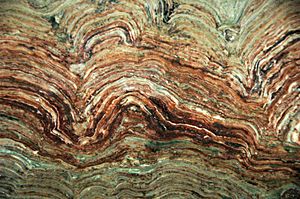
The rocks in Glacier National Park are some of the best-preserved ancient sedimentary rocks in the world. They hold amazing records of early life. Scientists have found six types of stromatolites here. These are very old organisms, like blue-green algae, that are about 1 billion years old.
Glaciers: Changing Landscapes=
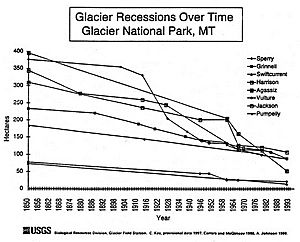
The mountains in Glacier National Park were shaped by huge glaciers from the last ice age. Most of these glaciers have melted over the past 12,000 years. You can still see their marks everywhere, like U-shaped valleys and large lakes.
The last cool period was the Little Ice Age, from about 1550 to 1850. During this time, the park's glaciers grew a bit. But since then, they have been shrinking.
In the mid-1900s, maps and photos showed that many of the 150 glaciers from a century earlier had disappeared. Pictures of Grinnell Glacier over the years clearly show how much it has shrunk.
|
By 2010, only 37 glaciers remained. Only 25 of these were large enough to be considered active. Scientists believe the remaining glaciers might melt by 2030. This melting is happening worldwide.
The melting glaciers affect the park's plants and animals. Species that need cold water might lose their homes. Less glacial meltwater could also mean lower stream levels in summer. This increases the risk of forest fires.
Park Climate and Weather=
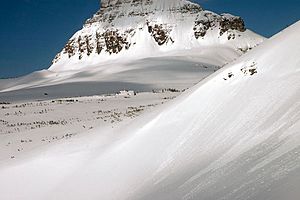
Glacier National Park has many different climates. This is because it crosses the Continental Divide and has big changes in elevation. The western side of the park is milder and wetter. It gets more rain and snow in winter and spring. Snow can fall any time of year, especially at high elevations.
Summers are usually warm, with daytime temperatures around 60 to 70°F (15 to 21°C). Nights are cooler, around 40°F (4°C). In the lower western valleys, summer days can reach 90°F (32°C).
The park is a great place for climate change research. Scientists study the melting glaciers and how fires affect forests. They also look at changes in plants and water levels. This research helps us understand global climate changes.
The air and water quality in Glacier National Park are excellent. There are no big cities or factories nearby to cause pollution. However, the cold, clear lakes can be easily affected by airborne pollutants. The park's water quality is rated A-1, the highest in Montana.
| Climate data for Glacier National Park, elev. 3,154 feet (961 m) | |||||||||||||
|---|---|---|---|---|---|---|---|---|---|---|---|---|---|
| Month | Jan | Feb | Mar | Apr | May | Jun | Jul | Aug | Sep | Oct | Nov | Dec | Year |
| Record high °F (°C) | 55 (13) |
58 (14) |
66 (19) |
83 (28) |
90 (32) |
93 (34) |
99 (37) |
99 (37) |
95 (35) |
79 (26) |
65 (18) |
52 (11) |
99 (37) |
| Mean daily maximum °F (°C) | 30.5 (−0.8) |
35.0 (1.7) |
43.2 (6.2) |
54.0 (12.2) |
64.5 (18.1) |
71.7 (22.1) |
80.0 (26.7) |
79.3 (26.3) |
67.5 (19.7) |
52.3 (11.3) |
37.3 (2.9) |
28.8 (−1.8) |
53.8 (12.1) |
| Mean daily minimum °F (°C) | 18.3 (−7.6) |
18.9 (−7.3) |
24.6 (−4.1) |
30.6 (−0.8) |
38.0 (3.3) |
44.3 (6.8) |
48.5 (9.2) |
47.1 (8.4) |
39.3 (4.1) |
32.0 (0.0) |
25.5 (−3.6) |
17.8 (−7.9) |
32.1 (0.1) |
| Record low °F (°C) | −35 (−37) |
−32 (−36) |
−30 (−34) |
3 (−16) |
13 (−11) |
24 (−4) |
31 (−1) |
26 (−3) |
18 (−8) |
−3 (−19) |
−29 (−34) |
−36 (−38) |
−36 (−38) |
| Average precipitation inches (mm) | 3.23 (82) |
1.98 (50) |
2.08 (53) |
1.93 (49) |
2.64 (67) |
3.47 (88) |
1.70 (43) |
1.30 (33) |
2.05 (52) |
2.49 (63) |
3.27 (83) |
3.01 (76) |
29.15 (739) |
| Average snowfall inches (cm) | 29.5 (75) |
16.8 (43) |
13.6 (35) |
2.9 (7.4) |
0.3 (0.76) |
0.0 (0.0) |
0.0 (0.0) |
0.0 (0.0) |
0.0 (0.0) |
1.7 (4.3) |
17.9 (45) |
34.3 (87) |
117 (297.46) |
| Average precipitation days (≥ 0.01 in) | 16.5 | 12.9 | 13.5 | 12.1 | 14.0 | 14.7 | 9.5 | 7.8 | 9.4 | 12.4 | 16.2 | 16.5 | 155.5 |
| Average snowy days (≥ 0.1 in) | 12.6 | 8.3 | 5.8 | 1.8 | 0.3 | 0.0 | 0.0 | 0.0 | 0.0 | 0.8 | 6.9 | 13.4 | 49.9 |
| Source 1: NOAA (normals, 1981–2010) | |||||||||||||
| Source 2: Western Regional Climate Center (extremes 1949–present) | |||||||||||||
Plants and Animals of Glacier National Park
Amazing Plant Life=
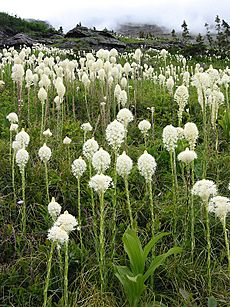
Glacier National Park is part of a huge, untouched wilderness. Almost all the plants and animals that were here when explorers first arrived are still present today. This makes it a great place for scientists to study ecosystems.
Over 1,132 plant species have been found in the park. The forests are mostly made up of coniferous trees like spruce, fir, and pine. You can also find deciduous trees like cottonwood and aspen at lower elevations. The "timberline" (where trees stop growing) is lower on the eastern side of the park. This is because of the colder winds from the Great Plains.
Above the forests, you'll find alpine tundra. Here, only grasses and small plants can grow because snow covers the ground for most of the year. Thirty plant species are found only in this park and nearby forests. Beargrass, a tall flowering plant, is common in July and August. Other wildflowers like monkeyflower and glacier lily are also seen often.
Sadly, whitebark pine trees have been badly damaged by a fungus called blister rust. This fungus is not native to the area. About 30% of these trees have died, and over 70% are infected. Whitebark pine nuts are a favorite food for bears and squirrels. Their decline affects these animals.
Diverse Animal Species=
Glacier National Park is home to almost all the animal species that historically lived here. This includes two threatened species: the grizzly bear and the lynx. While their numbers are stable in the park, they are rare in other parts of the U.S.
On average, one or two bear attacks happen each year. Since 1910, there have been 10 bear-related deaths. Scientists believe there are about 300 grizzlies in the park. Other common mammals include moose, mountain goats, bighorn sheep, and elk. Wolves naturally returned to the park in the 1980s.
Over 260 bird species have been recorded. You can see bald eagles, golden eagles, and osprey here. Colorful harlequin ducks live in the lakes. In the dense forests, you might spot great horned owls or Steller's jays.
Because of the cold climate, there are very few reptiles. Only two types of garter snakes and the western painted turtle live here. There are also six species of amphibians, like the western toad.
Twenty-three species of fish live in the park's waters. Native fish include the westslope cutthroat trout and Arctic grayling. The bull trout is a threatened species and must be released if caught. Non-native fish like lake trout have affected some native fish populations.
Understanding Forest Fires=
For a long time, forest fires were seen as bad for parks. But now we know they are a natural part of the ecosystem. Fires help clear dead trees and plants. They also add nutrients to the soil and help new plants grow.
Glacier National Park has a plan for managing fires. Fires caused by humans are usually put out. Natural fires are watched closely. They are only put out if they threaten people or buildings.
The park works with nearby communities to improve fire safety. Houses near the park are made more fire-resistant. Dead trees are removed to reduce fuel for fires. Warning systems help alert people about fire risks. On average, Glacier National Park has 14 fires each year. In 2003, a large fire burned 136,000 acres (550 km²) after a long drought.
Fun Things to Do in Glacier National Park
Glacier National Park is far from big cities. The closest airport is in Kalispell, Montana. Amtrak trains stop at East and West Glacier.
You can take tours on the park's main roads in restored 1930s White Motor Company buses. These are called Red Jammers. The drivers are called "Jammers" because of how they used to shift gears. These buses were updated in 2001 to run on propane, which is better for the environment.
Historic wooden tour boats, some from the 1920s, operate on the larger lakes. These boats have been running since 1927 and can carry up to 80 passengers.
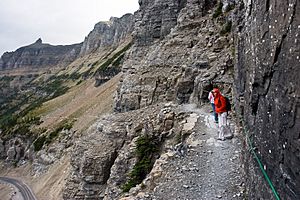
Hiking is very popular in the park. Over half of visitors go for a hike on the park's nearly 700 miles (1,100 km) of trails. Part of the Continental Divide National Scenic Trail goes through the park.
Dogs are not allowed on any trails. This is to protect both the dogs and the park's wildlife, like bears. Dogs are allowed in campgrounds that you can drive to and on paved roads.
You can go back-country camping at campsites along the trails. You need a permit for this. Many trails at higher elevations are covered in snow until July. Campgrounds that allow vehicles are found throughout the park. Most are open from mid-June to mid-September.
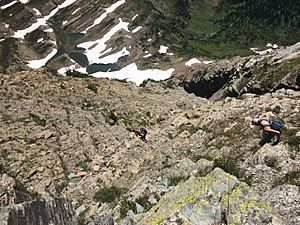
The park also attracts many climbers. The rocks are old and can be loose. A famous guide for climbing in the park is A Climber's Guide to Glacier National Park.
Glacier National Park is known for excellent fly fishing. You don't need a permit to fish in the park. If you catch a bull trout, you must release it right away because it's a threatened species.
Winter activities in Glacier are limited. Snowmobiling is not allowed. You can go cross-country skiing in the lower valleys, away from areas with avalanche risk.
Images for kids
-
Blackfeet camp at upper St. Mary Lake, c. 1916
See also
 In Spanish: Parque nacional de los Glaciares para niños
In Spanish: Parque nacional de los Glaciares para niños


